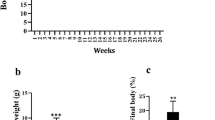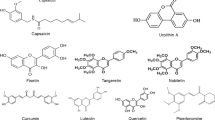Abstract
Melatonin exists as an active ingredient in several foods and has been reported to inhibit fatty liver disease in animals; however, its molecular mechanisms are not well elucidated. Herein, we explored effects of melatonin on lipid accumulation induced by oleic acid in HepG2 cells and characterized the underlying molecular mechanisms. Pretreatment with melatonin (0.1–0.3 mM) significantly inhibited accumulation of triglyceride and cholesterol induced by incubating HepG2 cells with high concentrations of oleic acid (oleic acid overload) (p < 0.05). Melatonin pretreatment induced phosphorylation of AMP-activated protein kinase (AMPK) and acetyl-CoA carboxylase (ACC), causing their activation and inactivation, respectively. Expression levels of peroxisome proliferator activated receptor-α (PPARα) and its target gene carnitine palmitoyl-CoA transferase 1 (CPT1), which are associated with lipolysis, were upregulated by melatonin, whereas expression of sterol regulatory element binding protein-1c (SREBP-1c), fatty acid synthase (FAS), and stearoyl-CoA desaturase-1 (SCD1), which are associated with lipogenesis, were downregulated. Melatonin did not change expression of genes involved in cholesterol metabolism, including 3-hydroxy-3-methylglutaryl CoA reductase (HMGR) and SREBP-2. Melatonin inhibits lipid accumulation induced by oleic acid overload in HepG2 cells. The phosphorylation and activation of AMPK may have important roles in inactivating lipid anabolic pathways and activating triglyceride catabolic pathways.




Similar content being viewed by others
References
Fan, J. G., & Farrell, G. C. (2008). Epidemiology of non-alcoholic fatty liver disease in China. Journal of Hepatology, 50, 204–210.
Ziamajidi, N., Khaghani, S., Hassanzadeh, G., Vardasbi, S., Ahmadian, S., & Nowrouzi, A. et al. (2013). Amelioration by chicory seed extract of diabetes- and oleic acid-induced non-alcoholic fatty liver disease (NAFLD)/non-alcoholic steatohepatitis (NASH) via modulation of PPARα and SREBP-1. Food and Chemical Toxicology, 58, 198–209.
Yin, Y., Li, Z., Gao, L., Li, Y., Zhao, J., & Zhang, W. (2015). AMPK-dependent modulation of hepatic lipid metabolism by nesfatin-1. Molecular and Cellular Endocrinology, 417, 20–26.
Dahlhoff, C., Worsch, S., Sailer, M., Hummel, B. A., Fiamoncini, J., & Uebel, K. et al. (2014). Methyl-donor supplementation in obese mice prevents the progression of NAFLD, activates AMPK and decreases acyl-carnitine levels. Molecular Metabolism, 3, 565–580.
Foretz, M., & Viollet, B. (2011). Regulation of hepatic metabolism by AMPK. Journal of Hepatology, 54, 827–829.
Serviddio, G., Bellanti, F., & Vendemiale, G. (2013). Free radical biology for medicine: learning from nonalcoholic fatty liver disease. Free Radical Biology for Medicine, 65, 952–968.
Alonso-Gonzalez, C., Gonzalez, A., Martinez-Campa, C., Menendez-Menendez, J., Gomez-Arozamena, J., & Garcia-Vidal, A. et al. (2016). Melatonin enhancement of the radiosensitivity of human breast cancer cells is associated with the modulation of proteins involved in estrogen biosynthesis. Cancer Letters, 370, 145–152.
Kocadagli, T., Yilmaz, C., & Gokmen, V. (2014). Determination of melatonin and its isomer in foods by liquid chromatography tandem mass spectrometry. Food Chemistry, 153, 151–156.
Cerezo, A. B., Leal, Á., Álvarez-Fernández, M. A., Hornedo-Ortega, R., Troncoso, A. M., & García-Parrilla, M. C. (2016). Quality control and determination of melatonin in food supplements. Journal of Food Composition and Analysis, 45, 80–86.
Anwar, M. J., Muhammad, B. Y., Bader, A. A., Abdulghani, M., Mahmood, D., & Haider, M. (2015). An insight into the scientific background and future perspectives for the potential uses of melatonin. Egyptian Journal of Basic and Applied Sciences, 2, 139–152.
She, M., Hou, H., Wang, Z., Zhang, C., Laudon, M., & Yin, W. (2014). Melatonin rescues 3T3-L1 adipocytes from FFA-induced insulin resistance by inhibiting phosphorylation of IRS-1 on Ser307. Biochimie, 103, 126–130.
Rui, B. B., Chen, H., Jang, L., Li, Z., Yang, J. M., & Xu, W. P. et al. (2015). Melatonin upregulates the activity of AMPK and attenuates lipid accumulation in alcohol-induced rats. Alcohol and Alcoholism, 2015, 51
Hatzis, G., Ziakas, P., Kavantzas, N., Triantafyllou, A., Sigalas, P., & Andreadou, I. et al. (2013). Melatonin attenuates high fat diet-induced fatty liver disease in rats. World Journal of Hepatology, 5, 160–169.
Julia, A., Ramón, R., Videla, L. A., Lilian, T., Myriam, O., & Paulina, P. et al. (2004). Increase in long-chain polyunsaturated fatty acid n - 6/n - 3 ratio in relation to hepatic steatosis in patients with non-alcoholic fatty liver disease. Clinical Science, 106, 635–643.
Cousin, S. P., Hügl, S. R., Wrede, C. E., Kajio, H., Myers, Jr, M. G., & Rhodes, C. J. (2001). Free fatty acid-induced inhibition of glucose and insulin-like growth factor I-induced deoxyribonucleic acid synthesis in the pancreatic beta-cell line INS-1. Endocrinology, 142, 229–240.
Chih-Li, L., Hsiu-Chen, H., & Jen-Kun, L. (2007). Theaflavins attenuate hepatic lipid accumulation through activating AMPK in human HepG2 cells. Journal of Lipid Research, 48, 2334–2343.
Gorgani-Firuzjaee, S., & Meshkani, R. (2015). SH2 domain-containing inositol 5-phosphatase (SHIP2) inhibition ameliorates high glucose-induced de-novo lipogenesis and VLDL production through regulating AMPK/mTOR/SREBP1 pathway and ROS production in HepG2 cells. Free Radical Biology and Medicine, 89, 679–689.
Yao, F., Zhang, M., & Chen, L. (2016). 5’-Monophosphate-activated protein kinase (AMPK) improves autophagic activity in diabetes and diabetic complications. Acta Pharmaceutica Sinica B, 6, 20–25.
Hardie, D. G., Schaffer, B. E., & Brunet, A. (2016). AMPK: an energy-sensing pathway with multiple inputs and outputs. Trends in Cell Biology, 26, 190–201.
Janovska, A., Hatzinikolas, G., Staikopoulos, V., Mcinerney, J., Mano, M., & Wittert, G. (2008). AMPK and ACC phosphorylation: effect of leptin, muscle fibre type and obesity. Molecular and Cellular Endocrinology, 284, 1–10.
Youli, X., Miaozong, W., Hongxia, L., Siqi, D., Erfei, L., & Mingbo, G. et al. (2015). Baicalin attenuates high fat diet-induced obesity and liver dysfunction: dose-response and potential role of CaMKKβ /AMPK/ACC pathway. Cellular Physiology and Biochemistry, 35, 2349–2359.
Vidyashankar, S., Sharath Kumar, L. M., Barooah, V., Sandeep Varma, R., Nandakumar, K. S., & Patki, P. S. (2012). Liv.52 up-regulates cellular antioxidants and increase glucose uptake to circumvent oleic acid induced hepatic steatosis in HepG2 cells. Phytomedicine, 19, 1156–1165.
Kim do, Y., Yuan, H. D., Chung, I. K., & Chung, S. H. (2009). Compound K, intestinal metabolite of ginsenoside, attenuates hepatic lipid accumulation via AMPK activation in human hepatoma cells. Journal of Agricultural Food Chemistry, 57, 1532–1537.
Acknowledgements
This work was supported by the National Natural Science Foundation of China (No. 31570687).
Author information
Authors and Affiliations
Corresponding author
Ethics declarations
Conflict of Interest
The authors declare that they have no conflict of interest.
Rights and permissions
About this article
Cite this article
Mi, Y., Tan, D., He, Y. et al. Melatonin Modulates lipid Metabolism in HepG2 Cells Cultured in High Concentrations of Oleic Acid: AMPK Pathway Activation may Play an Important Role. Cell Biochem Biophys 76, 463–470 (2018). https://doi.org/10.1007/s12013-018-0859-0
Received:
Accepted:
Published:
Issue Date:
DOI: https://doi.org/10.1007/s12013-018-0859-0




